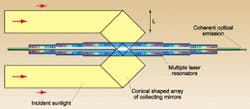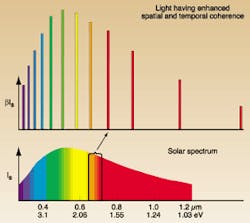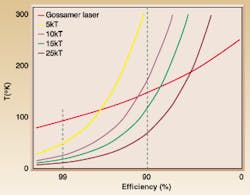High-energy lasers may put power in space
Richard L. Fork
With the support of NASA's Advanced Technology Division, a space-solar-power effort has identified high-energy lasers as an enabling technology for an optically based power infrastructure in space, using sunlight as the energy source. Using high-energy lasers, power would be propagated as coherent light through free space. Such a project is motivated by the billions of terawatts of sunlight continuously available as energy in near-Earth space. Another motivation is the ability to transmit gigawatts of power with high spatial precision at minimal loss over multimegameters of distance.
Recent work examining the basic physics of high-energy lasers found that such an infrastructure, while prohibitively expensive at this time, could be feasible in the next 40 years.1 In particular, advances in nanostructures and large space optics offer clear, albeit developmentally demanding, pathways to an economically viable system. Other important challenges are the need for high efficiency and innovative thermal management.
The problem of converting solar energy to coherent light is similar to that of optical switching in data communications. In essence, a photon must be switched from a state as a quantum of natural sunlight to a state as a quantum of an optical field, having close to the maximum possible coherence. The minimum cost per switched photon, paid as heat generated in the switch, is kT ln2, where k is Boltzmann's constant, and T is the temperature of the switch. In principle, this allows efficiencies greater than 90% for achievable temperatures. Coupled with the high efficiencies of photovoltaics illuminated by quasi-monochromatic light (about 65%), an efficiency of about 50% could be realized for delivering power from space to another site, such as Earth.
Required: new technologies
A major challenge is that the collecting structures require kilometer dimensions to access gigawatt power levels, as well as to collect sunlight and radiate waste heat. Designs that reduce areal density (mass per unit area) are favored because they reduce the resulting cost of "lift to orbit."2 The so-called Gossamer strategy of using minimum areal density in a spacecraft is particularly desirable. Projected areal densities range from as low as 0.1 to 1.0 kg/m2.
The Gossamer laser design uses 12 spectral bands and requires a total system area of about 20 L2, where L is the height of the cone-shaped collectors in kilometers (see Fig. 1). Thin collecting shells provide large surfaces with minimum areal density. The collecting system is composed of arrays of individual rotating mirrors disposed in two symmetric conical arrays. Multiple laser oscillators collect power from active mirrors that are distributed over the long slender primary laser structure (multicolored region). The resulting coherent light leaves through output coupling mirrors at the end of the laser structure.
Economic viability will require development of multiple technologies. One example is low-loss mirrors with absorptive losses of less than 1 part per million that can tolerate continuous intensities of about 1 kW/cm2 for decades. Sophisticated computer simulation, such as with ASAP of optical systems, for these large space structures will be valuable. Another need is for large, lightweight spectral cold filters with high transmission/reflection ratios for multiple spectral bands. The filters will need to operate in space for decades. Libraries of mechanical design software relevant to Gossamer laser structures will be required. Upgrades of software, such as AutoCAD and NE/Nastran, are likely to be needed. In addition, these lasers will require embedded computation capability, distributed sensors, and control technology. Furthermore, thermal management technologies will be needed, such as heat pipes that distribute heat in a space environment over distances ranging up to a meter with temperature differentials of a few degrees. These are just a few of the technologies needed.
Design strategies
The feasibility study identified four basic design strategies. The first is the use of thin-shell Gossamer-type structures with areal densities of less than 1 kg/m2. The second is the reduction of system temperature achieved by minimizing the switching energy with the assistance of the spectral multiplexing. The third strategy is the use of thin-disk active mirrors (about 100 µm thick) to optimize the removal of heat, reduce optical distortion and distribute the heat load. A fourth strategy is to track and collect the incident sunlight so as to achieve constant pump intensity at the active mirrors with minimal mechanical complexity and mass.
These design rules present conflicts between minimizing the switching energy, utilizing most of the bandwidth of solar radiation, and achieving laser oscillation threshold despite the short gain path of the thin-disk amplifiers. Spectral multiplexing of solar radiation is necessary to optimize efficiency. However, this multiplexing further decreases the already limited intensity of sunlight available for optical pumping (see Fig. 2). The short gain path of the thin disk and the need for laser oscillator action require optical cross sections for the laser transitions well beyond those typically available.
A potential solution to this problem appears to occur in current work on quantum dot lasers. There, and perhaps only there, the emission cross sections are sufficiently large to produce laser action in thin disks while also allowing the spectral multiplexing pump strategy needed to gain maximum efficiency. Also, quantum dots further facilitate the spectral multiplexing strategy in that the transition resonances are adjustable in wavelength. Combining the quantum dots with the thin-disk lasers is not a trivial feat, but the approach is consistent with fundamental laws and could well offer the only path to the required performance.
The long, slim aspect ratio of the Gossamer laser helps stabilize the satellite in the gravity gradient of near-Earth space. Furthermore, the ability to tailor the moments of inertia of the structure enables a strategy where the satellite can be oscillated about the radial direction to Earth with a 24-hour libration period. This provides a way to maintain the relationship of the incident sunlight to the input optics. Because the collecting mirror technology is scalable, the same basic structure can provide a range of output from kilowatts to gigawatts. The emitted power is proportional to the area of the collecting structure.
The system temperature and efficiency depend on the balance between the thermal radiation rate of the system as described by the Stefan-Boltzmann law and the heat generated by the switching process (see Fig. 3). The solar spectrum is assumed to be multiplexed, such that the switching energy dissipated in the active medium is qkT, where q is a measure of how closely the quantum defect (energy difference between the absorbed and emitted quanta) approaches kT ln2. The switching energy can be somewhat larger than the theoretical minimum of kT ln2 and still maintain a high efficiency. For example, the system can operate at 140 K at 90% efficiency for a quantum defect of 10kT. The low system temperature, as compared to other space laser designs, offers the important advantages of high efficiency, continuous operation, and long component life.
The economic viability of placing such a laser system in space will require significant reduction of current areal densities and cost of lift to orbit. Given anticipated progress by the year 2020, the cost of placing the spacecraft in orbit will still be about $20 billion.2 Using the projected areal density of 0.1 kg/m2 by 2040, and the projected cost of lift to orbit of $10 per kg at that time, the price for placing the structure in space could decrease to as little as $20 milliona small fraction of the total system. Safe delivery of gigawatt-level powers to Earth is possible now.3 With projected cost reductions, the approach might also become economically feasible.
Alternative strategies, such as using photovoltaics to excite diode lasers that pump solid-state lasers, appear less viable than the system examined here. Those systems include more components, are inevitably less efficient, and require larger mass. Microwave systems, in particular, cannot utilize the switching strategy outlined here. The microwave quantum energy, except for extremely high temperature, is small compared to kT.
Finally, the possibility of gigawatt-power coherent light from a Gossamer laser suggests a bootstrap strategy for "off-board" propulsion. A system lifted to orbit with such optically enabled propulsion strategies can be largely payload. In principle, for moderate sized payloads this could enable the $10/kg cost of lift to orbit projected for the 2040 time frame. There is, therefore, hope that Gossamer lasers can serve in multiple ways to enable a novel optically based space power infrastructure.
ACKNOWLEDGMENTS
The author would like to thank the EE 453 Laser Systems class at the University of Alabama in Huntsville, as well as John C. Mankins, Joe T. Howell, Steve J. Anacker, Spencer T. Cole, Andrew S. Keys, Wesley W. Walker, and Donna Fork for valuable discussions.
REFERENCES
- R. L. Fork, S. T. Cole, W. W. Walker, S. J. Anacker, Optical Space Power Infrastructure: Gossamer Laser, to be published in Optics Express.
- NASA URL: http://www.msfc.nasa.gov/NEWSROOM/background/facts/astp.htm.
- M. H. Smith, R. L. Fork, S. T. Cole, Optics Express, 8, 537 (2001).
RICHARD L. FORK is a professor of electrical and computer engineering at the University of Alabama, Optics Building 456, Huntsville, AL 95899; e-mail: [email protected].



